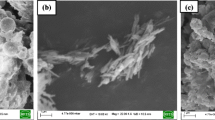Abstract
In this work we studied the phenol sorption from contaminated water onto modified clay mineral vermiculite and bentonite by insertion of hexadecyltrimethylammonium in the interlayer of clays. The non modified clays showed negligible interaction with phenol. The experimental data were treated using the Freunlich equation which had a good fit. The removal percentages were higher than 35% for modified vermiculite and for modified bentonite, 30%. Vermiculite and bentonite were compared for the removal of phenol from an aqueous solution based on the maximum adsorption capacity of each adsorbent, and no significant difference was found. The adsorption mechanism for both is the same, according to the results. Although, there is a lack of studies using vermiculite for this purpose, it can be concluded that hydrophobic modified vermiculite is very effective for removing phenol from water. Hydrophobic modified bentonite also remove phenol, but in lower proportions.

Similar content being viewed by others
References
Abate, G., & Masini, J. C. (2000). Sorption of atrazine, propazine, deethylatrazine, deisopropylatrazine and hydroxyatrazine onto organovermiculite. Journal of the Brazilian Chemical Society, 16, 936–943.
Aguiar, M. M. R. P., Novaes, A. C., & Guarino, A. W. S. (2002). Removal of heavy metals from wastewaters by aluminosilicate. Quimica Nova, 25, 1145–1154. doi:10.1590/S0100-40422002000700015.
Banat, F., & Al-Ashed, S. (2000). Biosorption of phenol by chicken feathers. Environmental Engineering and Policy, 2, 85–90. doi:10.1007/s100220000022.
Banat, F. A., Al-Bashir, B., Al-Ashed, S., & Hayajneth, O. (2000). Adsorption of phenol by bentonite. Environmental Pollution, 107, 391–398. doi:10.1016/S0269-7491(99)00173-6.
Béguin, F., & Ania, C. O. (2007). Mechanism of adsorption and eletrosorption of bentazone on activated carbon cloth in aqueous solution. Water Research, 41, 3372–3380. doi:10.1016/j.watres.2007.03.031.
Bowman, R. (2003). Applications of surfactant-modified zeolites to environmental remediation. Microporous and Mesoporous Materials, 61, 43–56. doi:10.1016/S1387-1811(03)00354-8.
Bowman, R., Sullivan, E. J., & Li, Z. (2000). Natural zeolites for the third millennium. Napoly, Italy: C. Colella and F. A. Mumpton.
Bowman, R. S., Ranck, J. M., Weeber, J. L., Katz, L., & Sullivan, E. J. (2005). BTEX removal from produced water using surfactant-modified zeolite. Journal of Environmental Engineering, 131, 434–442. doi:10.1061/(ASCE)0733-9372(2005)131:3(434).
Boyd, S. A., Lawrence, M. A. M., & Kukkadapu, R. K. (1998). Adsorption of phenol and chlorinated phenols from aqueous solution by tetramethylammonium- and tetranethylphosphonium-exchanged montmorilonite. Applied Clay Science, 13, 13–20. doi:10.1016/S0169-1317(98)00009-X.
Gales, M., & Booth, R. (1976). Automated 4AAP phenolic method. Journal of the American Water Works Association, 68, 540.
Hamaker, J. W., & Thompson, J. M. (1972). Adsorption. In C. A. Goring, & J. W. Hamaker (Eds.), Organic chemicals in the soil environment, vol. 1 (pp. 19–143). New York: Marcel Dekker.
Hesse, P. R. (1971). A textbook of soil chemical analysis. London: Murray.
Juang, R. S., Lin, S., & Tsao, K. H. (2002). Mechanism of sorption of phenols from aqueous solutions onto surfactant-modified montomorillonite. Journal of Colloid and Interface Science, 254, 234–241. doi:10.1006/jcis.2002.8629.
Klapyta, Z., Fujita, T., & Iyu, N. (2001). Adsorption of dodecyl- and octadecyltrimethylammonium ions on a smectite and synthetic micas. Applied Clay Science, 19, 5–10. doi:10.1016/S0169-1317(01)00059-X.
Koskinen, W. C., Carrizosa, M. J., & Hermosin, M. C. (2004). Interaction of acidic herbicides bentazone and dicamba with organoclays. Soil Science Society of America Journal, 68, 1863–1866.
Krishna, B. S., Murty, D. S. R., & Prakash, J. B. (2001). Surfactant-modified clay as adsorbent for chromate. Applied Clay Science, 20, 65–71. doi:10.1016/S0169-1317(01)00039-4.
Lee, D. H., Cody, R. D., Kim, D. J., & Choi, S. (2002). Effect of soil texture on surfactant-based remediation of hydrophobic organic-contaminated soil. Environment International, 27, 681–688. doi:10.1016/S0160-4120(01)00130-1.
Mortland, M. M., Boyd, S. A., Chiou, C., & Lee, J. F. T. (1989). Shape-selective adsorption of aromatic molecules from water by tetramethylammonium-smectite. Journal of the Chemical Society, Faraday Transactions I, 85, 2953–2962. doi:10.1039/f19898502953.
Nir, S., Zadaka, D., Mishael, Y. G., & Polubesova, T. (2007). Modified silicates and porous glass as adsorbent for removal of organic pollutants from water and comparison with activated carbons. Applied Clay Science, 36, 174–181. doi:10.1016/j.clay.2006.04.012.
Polubesova, T., Zadaka, D., Groisman, L., & Nir, S. (2008). Water remediation by micelle-clay system: Case study for tetracycline and sulfonamide antibiotics. Water Research, 40, 2369–2374.
Rytwo, G., Kohavi, Y., Botnick, I., & Gonen, Y. (2007). Use of CV- and TPP-montomorillonite for the removal of pryority pollutants from water. Applied Clay Science, 36, 182–190. doi:10.1016/j.clay.2006.04.016.
Scott, G. V. (1968). Spectrophotometric determination of cationic surfactants with Orange II. Analytical Chemistry, 40, 768–773. doi:10.1021/ac60260a038.
Shukla, S. S., Yu, L. J., Dorris, K. L., & Shukla, A. (2005). Removal of nickel from aqueous solutions by sawdust. Journal of Hazardous Materials, B121, 243–246. doi:10.1016/j.jhazmat.2004.11.025.
Yapar, S., Özbudak, V., Dias, A., & Lopes, A. (2005). Effect of adsorbent concentration to the adsorption of phenol on hexadecyl trimethyl ammonium. Journal of Hazardous Materials, B121, 135–139. doi:10.1016/j.jhazmat.2005.01.021.
Acknowledgments
We are grateful to CNPq (Conselho Nacional de Desenvolvimento Científico e Tecnológico, Brazil) for the financial support of this work (Processo 409955/2006-0 and Processo 471211/2006-0). Also we thanks to the anonymous reviewer for helpful suggestions.
Author information
Authors and Affiliations
Corresponding author
Rights and permissions
About this article
Cite this article
Froehner, S., Martins, R.F., Furukawa, W. et al. Water Remediation by Adsorption of Phenol onto Hydrophobic Modified Clay. Water Air Soil Pollut 199, 107–113 (2009). https://doi.org/10.1007/s11270-008-9863-0
Received:
Accepted:
Published:
Issue Date:
DOI: https://doi.org/10.1007/s11270-008-9863-0




